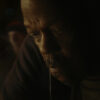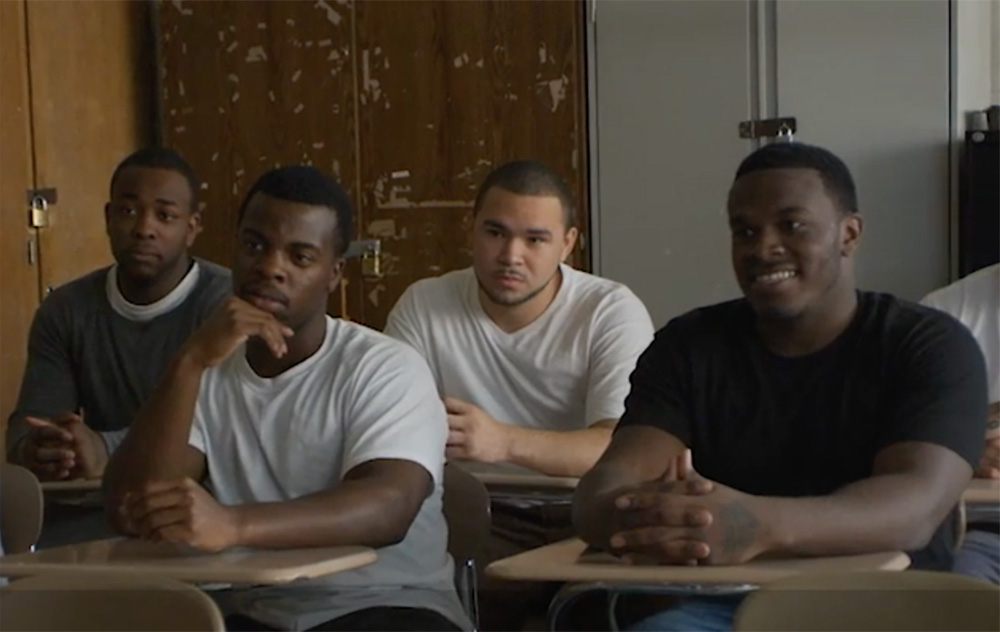In a nearly five-decade career that’s spanned stints at National Public Radio and Disney to ultimately starting her own production company, Elena Francesca Engel has found a way to work around just about anything, though staging a production of John Leguizamo’s one-man show “Ghetto Klown” inside a prison for the short “John Leguizamo: Live at Rikers” was another matter entirely.
“Going through security was interesting with all that equipment,” Engel now says with a laugh. “And we had a lot of rules and regs that I had to impart to my crew.”
It’s a testament to all of them that one loses sight of the setting, even the inmates it seems for a time, as Leguizamo takes to the stage at New York City’s central jail where he entertains with a soul-baring performance, recounting a hard knock life growing up in the city. But for this particular audience, he’s quite conscious in acknowledging that while he found a productive creative outlet for all his pent-up energy, the opportunity was there for him to be sitting where they all are today, caught in a vicious cycle of living behind bars when the path to being a productive member of their communities just doesn’t seem to exist. To that end, Engel shifts the spotlight from Leguizamo to the men he meets inside Rikers who are afforded a rare compassionate ear to talk about their hopes, fears and aspirations, suggesting that while they’ve used their time inside to improve themselves, the prison system itself needs reform if there is no way they can receive a second chance at a civilian life.
Working with the organization Getting Out and Staying Out, Engel and Leguizamo reveal there are just as worthwhile stories to tell among the men at Rikers as the one Leguizamo shares himself and giving them air provides at least some sense of freedom, even if the reality remains that it’s difficult for the incarcerated to ever be seen as anything else. With “John Leguizamo Live at Rikers” set to ignite a conversation about what can be done to ease the way for those who have served their time and appear ready to reenter society starting with its premiere at Tribeca, where matinee screenings of the short this Sunday and Wednesday will be followed by Q & As with Engel and representatives from GOSO, the director spoke about the personal calling to make the film, how Leguizamo and the men at Rikers brought the best out of each other and the challenges of filming inside of a high security prison.
How did this come about?
It’s been interesting. At the root of the conception of this film is a deeply personal story, inspired by an immediate family member who was sentenced to prison for a nonviolent crime and somebody I love very much. That just catapulted this trajectory of life that nobody ever expected and it was a harsh experience that we all experienced that forced me to recognize the lack of human consideration and dignity in the American Justice system. I felt that even though I was powerless to change that person’s fate, I could at least offer up the possibility of a different, more empathetic and hopeful perspective on all justice-involved young men and women. The crazy thing is I didn’t realize it at the time [I was making “John Leguizamo: Live at Rikers”] that I was actually doing that. Nobody knew. While I was directing and producing this project, my heart was completely into it and John didn’t know until later and he said, “Geez, Elena, this documentary should be about you.” But it’s not about me. It’s about what John and I wanted to do to bring light to the subject of recidivism.
How did that take this form?
My entire family family became involved with the Harlem-based recidivist organization Getting Out and Staying Out, which was started by the amazing Mark Goldsmith, and that’s how I met John, who is also involved in GOSO — I went to a party and John was there. I met him on the dance floor and we started having a conversation because I was an executive producer at Walt Disney for many years and we started comparing many notes. I said, “Have you ever been to Rikers Prison?” And he said, “Yeah, and it wasn’t such a great experience.” And he said, “Well, they threw me into the basketball court. No acoustics. I don’t think I even had a microphone, so I think only the first two rows could hear me and the rest of them couldn’t, [but] I’d love to go back.” So I said, “Let’s go back.”
We agreed and [thought] he could perform “Ghetto Klown,” his one-man autobiographical show, and the rest was about four months of me trying to convince the New York Department of Corrections to let us go there. After many meetings, they realized how famous he was and how this could be a really good thing for everybody, so they graciously allowed John to perform at the George Motchan Center, which is the holding center where justice-involved young men are waiting for sentencing to go to court. They never before had ever done this in the auditorium there, which was used for officer graduations. So we went in and we had a rehearsal and we had over 400 inmates that were escorted in on the day of the performance.
That’s only half the film of course, because there are also these breakout rooms where John talks to some of the inmates. Was that always part of this?
Oh, that was a part of this. Being involved at GOSO and being advocates, John and I really wanted to make the film in which the participants who are demonized even after fulfilling their debt to society have an opportunity to express themselves. We wanted to make a film that depicted justice-involved young men seeking dignity, but at the same time highlighting the importance of a highly successful effective organization that provides them with opportunities for what they call the three “Es” – emotional support, which is what my film heavily leans towards, education and employment.
Knowing the autobiographical aspect of “Ghetto Klown” very well and the fact that John basically shares his deepest demons and his struggles in life, all of those themes were perfect for the kinds of conversations that I wanted him to have with the inmates that we call our GOSO clients because they had signed up for the program and they got involved from the moment they got into prison until the moment they get out. That’s their commitment. So those things were there and I constructed questions, but [John] went off-script, which he will do and is fabulous. [And beforehand] John didn’t perform the entire play. He performed about 40 minutes that he selected around what we were trying to answer the questions we were trying to reach, and he was very tuned into the clients, and we got these two groups – one in the auditorium and one in the classroom, the high school classroom at Rikers.
It sounds like the groundwork was there, but was it a challenge to weave together in the edit? It’s really seamless.
The material was there. I’m not traditionally a documentary maker, and we did not know what improvisational answers or even questions that would come up, but as a director/producer, I wanted John to feel comfortable and the guys to feel comfortable and to share their hopes, their dreams, their ideas for the future, their regrets and so they did because they felt he had expressed his to them, so there was a reciprocity there that was beautiful to behold. In the editing process, there was a lot of material to comb through and I want to give a lot of credit to my producer Ben Konigsberg, who steered a great deal of that with our editor Brad Allgood, Ben Montez and Abigail Fuller jumped in a little bit and we made those choices, but I wanted that sensitivity and that emotional aspect of what was going on for these guys to be apparent. I’m very critical, having been a filmmaker for so many years, but I still get teary eyed when I look at it. There’s still moments that catch me.
The last line that knocked our socks off was when Benjamin, the one that wants to be a psychologist, looks up at John and they all thank him for coming, but he’s the one who thanks him for “giving us a little bit of love” — he thanks him genuinely — and then the show ends and [John] receives his applause and he gets to leave. He gets to leave twice — and they don’t. And I remember turning the cameras – I had five REDs in the audience and I had everybody turn around to show the exit of the prisoners and their experience of what that was like and then he comes walking down the hallway with the interviewees and says, “Well, here we go.” But he goes and they go back. That was the emotional moment I wanted to convey.
You mention five cameras – what were the logistics involved in capturing this?
I had a crew of about 20 people all together, and I have to say all pro-bono. It was a lot of convincing, a lot of reaching out to people and for the most part, that’s what this film has been engineered on was this devotion and excitement and passion for the subject and working with John. I had five camera guys and Fortunato Procoppio, the [director of photography] who’s very talented, he does a lot of work in both television and film and we had monitors and the whole thing. But the experience of going to a prison was amazing. Myself and Abigail were the only females at the prison. There were a lot of female guards, but you couldn’t go anywhere without being escorted by guards. And we were all a little nervous, like John says in his pre-interview, “I don’t know what to expect. I don’t know if they’re going to laugh at what I’m sharing with them or are they going to understand it,” but he just went out there and did his thing, which is fabulous and they got it. They really got it. I was standing right in the middle of it and it was palpable.
What’s it like getting out into the world now?
I am so excited to be able to do that. I am excited to promote programs like Getting Out and Staying Out that are so successful at keeping these guys out of prison because the statistics are not great. Typically, two thirds in this country go back in within three years. Programs like GOSO have recidivist rates of only like 15 percent, so my hope is that the personal truths, voiced by the participants in the film will inspire audiences to look further into the emotional and social issues of incarceration and recidivism because when these young men have an opportunity to talk about what’s most important to them, there is just huge enormous richness to be found in their self-esteem and their desire for a better future. We all witnessed this just during the making of this film and if people pick that up from this film, that’s what I’m most excited for.
“John Leguizamo: Live at Rikers” will screen at Tribeca on June 12th at 2 pm at the OKX Theater at BMCC TPAC, June 15th at the Cinepolis Chelsea at 12:30 pm and June 16th at 9:30 pm at the Village East. It will also be available to stream beginning June 14th at 6 pm through the end of the festival on June 19th.




